VW Tiguan vs Honda CR-V vs Toyota RAV4 video group test
November 25, 2016 by carwow staff
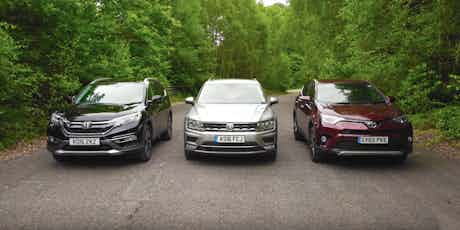
A combination of a chunky styling, great visibility and a practical cabin makes crossovers such as the VW Tiguan, Honda CR-V and the Toyota RAV4 perfect for everyday family use. We’ve compared these three cars side-by-side to find out which is best…
Use our new car deals page to view the latest carwow offers or head over to our Hyundai Tucson vs Nissan Qashqai vs Kia Sportage group test for more help picking the perfect SUV.
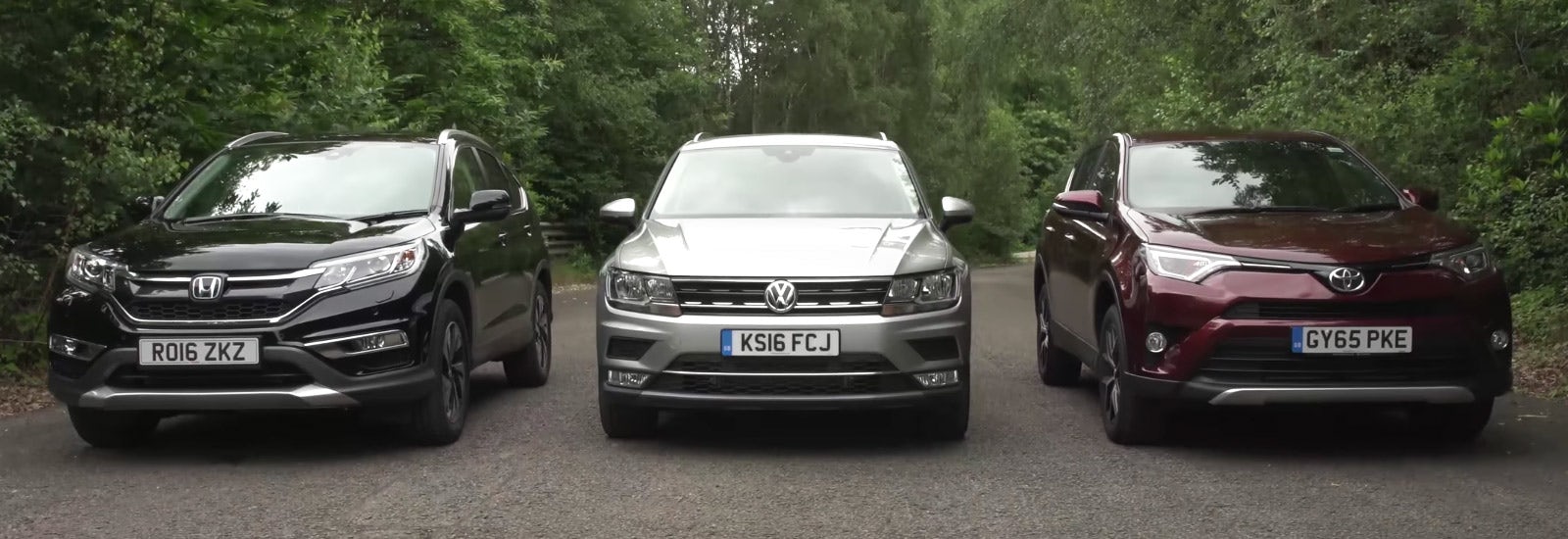
Price
The VW Tiguan is the cheapest of the three cars here to buy. Entry-level S models cost from just £22,920 and come with 17-inch alloy wheels, air conditioning and an eight-inch touchscreen infotainment system as standard.
The £23,025 Honda CR-V is slightly more expensive than the basic Tiguan but still comes with cruise control, air conditioning and Bluetooth connectivity as standard. You’ll need to upgrade to the £23,865 S Navi model to get satellite navigation, however.
All Toyota RAV4s feature sat nav as standard alongside 17-inch alloy wheels, LED daytime running lights and heated door mirrors. Entry-level versions will set you back £23,755 while top-spec £34,170 models undercut both the range-topping Tiguan and CR-V by £2,290 and £4,880 respectively.
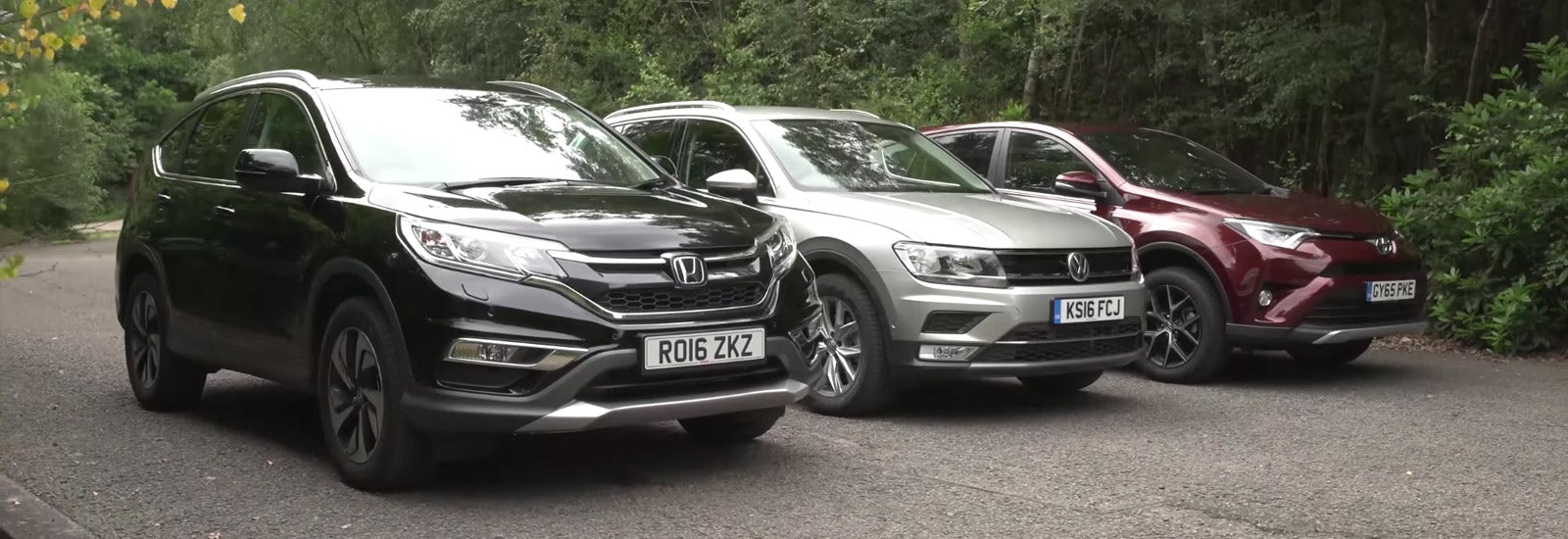
Design
From the outside, the Tiguan shows off the latest evolution of VW’s crisp styling. Every bonnet line, door crease and light looks a little sharper than it did on the old model. It’s certainly classy, but might be a little too understated for some buyers.
Parked beside the Tiguan, the CR-V looks a little fussy. There are some neat details – such as the headlights that seamlessly blend into the shiny front grille – but the tacked-on rear spoiler on top spec models looks a little cheap.
The RAV4 is certainly the most eye-catching of the bunch. Its sharp lines, bold shape and oversized brake lights look significantly more modern than the other two. It might not be to everyone’s tastes, but it certainly stands out.

Interior
The Tiguan’s cabin is sensible and sturdy. Its dashboard is clearly laid out and most of the bits you’ll regularly touch feel solid and upmarket. Unfortunately, the plastics just below the dashboard are hard and scratchy and door trims are equally cheap-feeling. On the plus side, its infotainment system is the best here. It’s not only the slickest to use, but it comes equipped with all important Android Auto and Apple CarPlay connectivity.
The Honda’s infotainment setup is by far the weakest of our trio – the screen is small, the graphics are clunky, it’s slow to respond and illogically laid out. Elsewhere, there are some bizarre, oddly-placed buttons – the cruise control switch is labelled ‘Main’, for no discernable reason. These little niggles are a shame because the Honda’s dashboard design is more imaginative than the Tiguan’s and features better quality materials, too.
The RAV4’s cabin is a mismatch of some lovely, upmarket trim and a number of lacklustre, scratchy plastics – the top of the dashboard suffers from a particularly cheap-feeling finish. The navigation system is nice enough to use but it lacks the Tiguan’s excellent connectivity features.

Practicality
The Tiguan wins the practicality stakes thanks to its huge 615-litre boot, impressive rear legroom and a seemingly endless selection of cubbies. Not only can the rear seats slide forwards to offer more boot space but they recline, too – perfect for a quick snooze on longer trips. The adjustable boot floor and completely flat load bay makes loading large items easy while the front passenger seat can be folded down to carry extremely long items.
The Honda loses out the VW when it comes to rear legroom but, with the widest cabin here, it’s the best for carrying three people in the back. It offers the highest driving position, too, so it’s perfect for those after a commanding view of the road ahead. The 589-litre boot isn’t quite a match for the VW in terms of space and the load floor isn’t completely flat either.
The RAV4’s boot comes with a few useful features, including a dividing net to secure smaller items. With the rear seats folded it can carry more luggage than either the VW or Honda and there’s plenty of room for tall adults in its roomy cabin, too. It’s a shame that the central rear seat is a little uncomfortable, however.
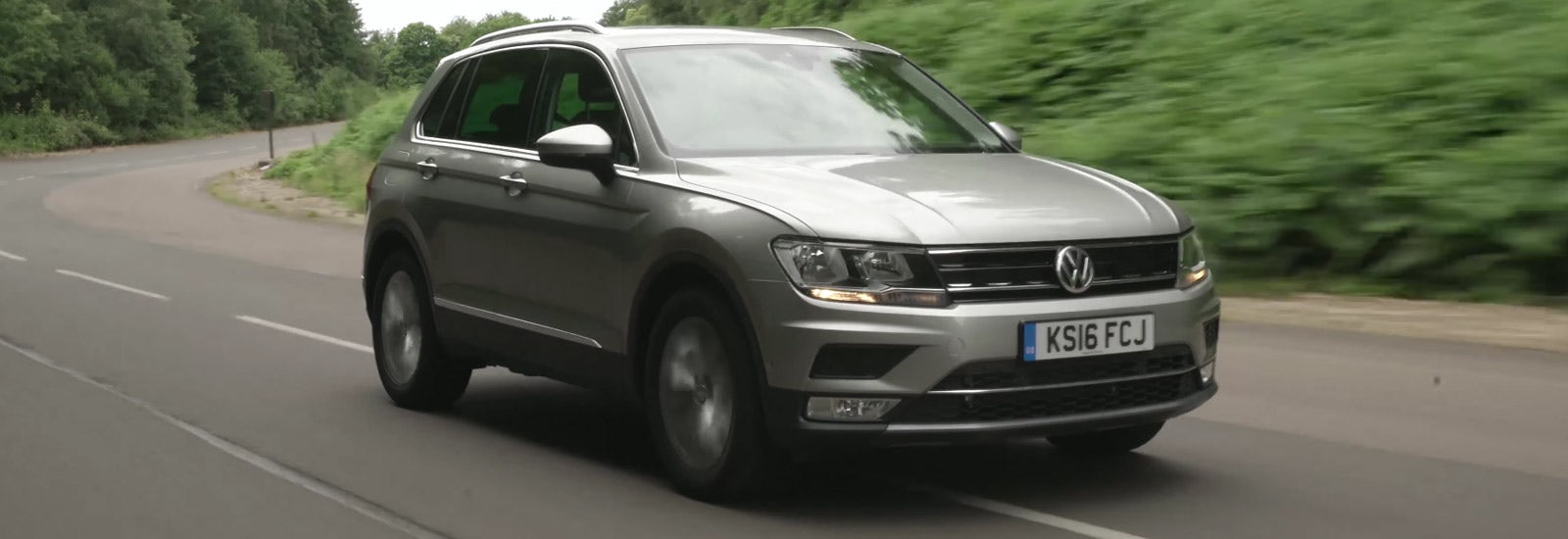
Engines
The Tiguan offers a choice of three petrol and four diesel engines. Mid-range units come with front-wheel drive only while more powerful versions come with four-wheel drive as standard.
The most frugal model is the 113hp 2.0-litre diesel that’ll return 60.1mpg. At the other end of the scale sits a bi-turbocharged version of the same unit. It offers more than double the power of the entry-level model and can sprint the Tiguan from 0-62mph in a seriously rapid 6.5 seconds. If you regularly cover shorter distances, you’ll be better off with one of VW’s smooth and refined petrol engines, however.
The Honda CR-V engine lineup is much more straightforward – there’s one petrol and a pair of diesels to choose from. The most frugal engine is the 1.6-litre diesel fitted to front-wheel drive models – it can return 64.2mpg.
With one diesel, one petrol and one petrol hybrid on offer, the RAV4 comes with the most limited choice of engines. The hybrid pairs a 2.5-litre unit with an electric motor to return a decent mix of performance and economy – Toyota claims it can return 156.9mpg. Its CVT automatic gearbox is a little noisy, however – we’d choose the quieter and more affordable diesel model instead.

Driving
There was a time when high-riding SUVs such as these offered all the stability of a rickety rope bridge. The Tiguan shows just how far they’ve come – it’s brilliantly composed, stable and comfortable. It offers great all round visibility and it’s quiet at motorway speeds, too.
The Honda doesn’t feel quite so happy through the bends. Its soft suspension setup and tall body make it lean and wallow in tight corners. It does, however, boast the smoothest ride of the three cars here and the most comfortable seats, too. As an added bonus, its light steering should help make parking a doddle.
The RAV4’s low dashboard offers good visibility and makes it the easiest to manoeuvre through a tight carpark. Rear visibility is better than its VW and Honda rivals, too. The ride and handling mix can’t quite match the VW, but it’s still far more fun to drive than the Honda. Unfortunately, the RAV4’s cabin can’t suppress wind and road noise quite as well as the competition.
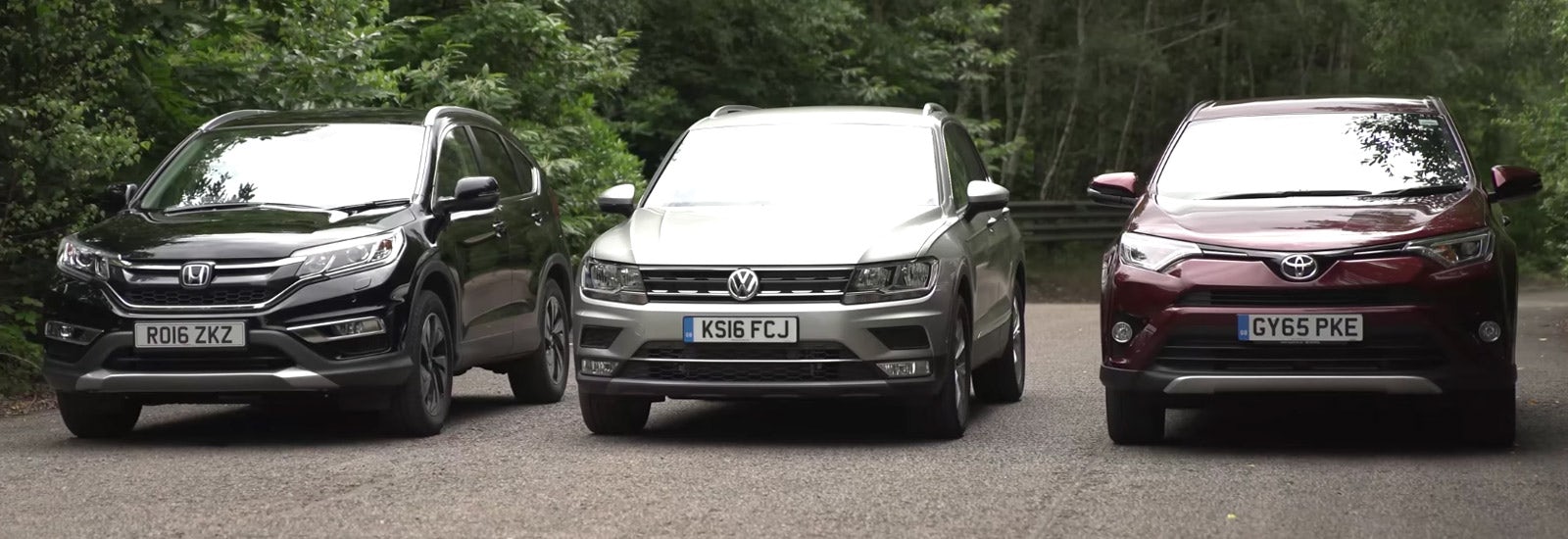
Verdict
Picking a winner is tough – regardless of which you choose, you’ll be getting a well-built, spacious crossover that’s easy to live with. The CR-V’s cabin feels the best built and the soft suspension makes it comfortable on the move – but it’s neither the best to drive nor the most economical car here.
The Toyota RAV4 looks the most distinctive inside and out and there’s loads of room for people and luggage in its spacious cabin. A limited choice of engines and some cheap feeling trim pieces mean it doesn’t quite offer enough to win our test, though.
In the end, it’s the VW Tiguan that proves to be the best all-rounder. Not only does it boast the best handling, a decent interior and a range of economical engines, but it’s the most competitively priced car here, too.
Save money on your new car
Head over to our new car deals page to see how much you could save. If you’re not sure what to buy, head over to our car chooser tool or use our PCP calculator to get a better idea of how much a new car could cost you per month.















